Rajasthan Board RBSE Class 12 Biology Notes Chapter 10 Photosynthesis Notes
Introduction
1. Green plants manufacture or synthesize their food in the presence of sunlight. All living organisms depend on the food synthesized by plants. This process of synthesis of food by green plants in the presence of sunlight is called photosynthesis.
2. Photosynthesis is the only activity on the earth in which sunlight energy is trapped by green plants and is converted in to chemical energy in the form of food (complex organic compounds).
3. For their energy requirements, animals depend on plants directly or indirectly.
4. Difintion : “Sensitized photochemical oxidation reduction reactions between hydrogen donor water and C02 is called photosynthesis”. (Rabinowitch 1956).
Synthesis of food by green parts of plant in the presence of sunlight, by using H20 and C02 is called photosynthesis. The process can be shown by the following reaction.
![]()
Milestones in Photosynthesis Research
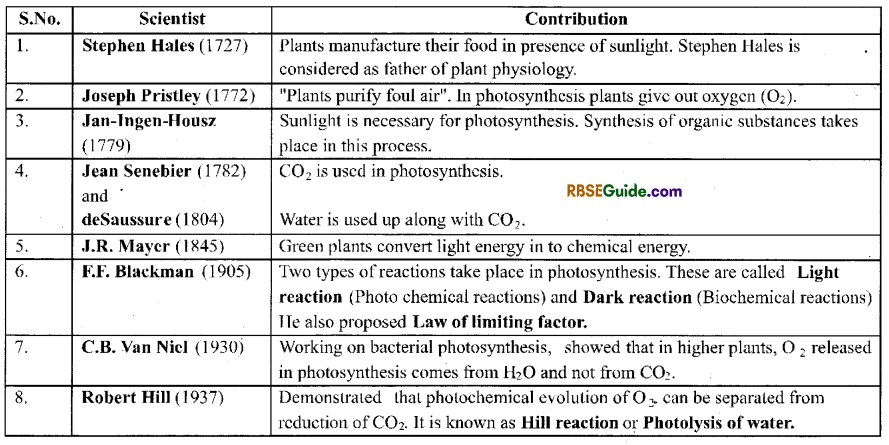

![]()
In the process of photosynthesis :
- Light energy brings about oxidation of water.
- The energy produced in oxidation brings about reduction of CO2 in to sugar.
- Oxygen is released as a by-product of the process of photosynthesis.
History of Photosynthesis
1. Although the process of photosynthesis is most important for all living organisms, it’s actual history starts from 18th century.
2. The history of photosynthesis can be divided into two periods.
- Pre-isotope period. (1800-1925)
- Post isotope period (1925-till date)

Site of Photosynthesis
1. All reactions of photosynthesis take place in the cell organell chloroplast.
2. Chloroplast are found in the mesophyll cells of leaves and also in all the green parts of plant.
3. In one cell of mesophyll 20-40 chloroplasts may be found.
4. In higher plants the chloroplast are discoid or lens shaped structure of 4-10 pm diameter.
5. Each chloroplast is bounded by two unit membranes made up of lipids and proteins.
6. The outer membrane is permeable to proteins whereas the inner membrane is impermeable to proteins.
7. The inner space of chloroplast is differentiated in to two parts
- Stroma and
- Grana.
8. Stroma is the matrix part of chloroplast. It is filled with proteinaeous fluid and contains 70 ‘S’ ribosomes, small circular DNA, osmophilic droplets, dissolved salts and several enzymes.
![]()
9. Grana is the most important part of chloroplast.
10.Each chloroplast may contain 40-60 grana.
11. A granum consists of lamellar structures which are arranged one over die other like stack of coins. These lamellar structures are called thylakoids.
12. Different grana remain connected with the hlep of stroma lamella or frets.
13. Photosynthetic pigments, chlorophyll and carotenoids are found in the thylakoid membrane.
14. Thus grana region of chloroplast is the site of light reaction of chloroplasts.
15. Not all the wavelengths of light can be absorbed by plant pigments.
16. The protosynthetic pigments can absorb more of purple, blue and red colour part of wavelength of visible spectrum.
17. This pigment part is reffered as photosynthetically active radiation (PAR).
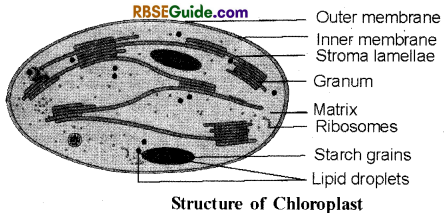
18. According to Park and Pan (1964), minute, spherical granules are found on the inner surface of thylakoid. These are called quantasomes.
19. The quantasome functions as photosynthetic unit.
20. Normally, each quantasome consists of 230 chlorophyll molecules (160 chi. ‘a’, 70 chi. ‘b’); 48 carotenoids; 116 phospholipid and other molecules along with enzymes.
Photosynthetic pigments
21. Photosynthesis is a photo-biochemical reaction and light energy is absorbed by pigments present in chloroplast.
These pigments are called photosynthetic pigments and are of three types :
- Chlorophyll
- Carotenoids
- Phycobilins.
22. Chlorophyll is the main pigment whereas carotenoids and phycobilins function as accessory pigments.
(i) Chlorophyll :
- Chlorophyll is green coloured pigment and is the main pigment involved in photosynthesis. This is found in higher amount than the other pigments and it is soluble in organic solvents.
- Seven types of chlorophyll pigments are known so far. These are Chi ‘a’, ‘b’, ‘c’, ‘d’, ‘e’, bacleoriochlorphyll and bacterioviridin (Chlorobium chlorophyll).
- Of these, chlorophyll ‘ a ’ is found in all photosynthetic plants except bacteria.
- Chlorophyll b functions as accessory pigment and is found along with chi. a in green algae (chlorophyceae) and all the photosynthetic Higher plants.
- Chi. ‘c’, ‘d’ and ‘e’ are found only in some algae and bacterio-chlorophyll and bacterioviridin are found in some bacteria.
Structure of Chlorophyll molecule:
1. Chemical structure of chlorophyll was first studied by Wilstatter, Stoll and Fisher (1912).
2. The chlorophyll molecule is a typical porphyrin derivative having a cyclic tetrap rrolic structure with a ring containing magnesium (Mg) atom at it’s centre.
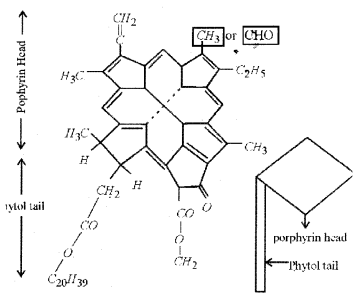
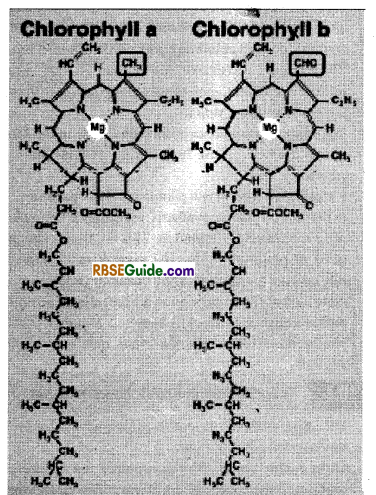
3. From one of the pyrrole ring, extends a phytol chain.
4. The top of the molecule consist of four pyrrole rings which form a tetrapyrrolic ring by mutual bond formation.
5. Empirical formula of chlorophyll ‘ a ’ molecule is C55 H72O5 N4 Mg and that of chlorophyll ‘b’ molecule is C56 H72 Of N4Mg.
![]()
6. Difference between Chi ‘a’ and Chi ‘b’ is that in Chi ‘a’ on third carbon of porphyrin-CH3 is found where as in Chi ‘b’ it is replaced by -CHO group.
7. Chi ‘a’ is bluish green in colour and Chi ‘b’ is yellowish green coloured.
8. The head region of chlorophyll is hydrophilic and the tail region is hydrophobicon account of this it has polar nature.
9. Chlorophyll is formed from it’s precurssor, protochlorophyll.
Carotenoids
- Carotenoids were first discovered by Weckenroder (1831) in carrot.
- These pigments are found with chlorophyll pigment.
- These pigments absorb energy from sunlight and transfer it to chlorophyll. Hence these are called accessory
pigments.
Two types of carotenoids are found in plants.
(a) Carotene-
- Reddish colour of carrot is due to carotene.
- Carotene pigment is composed of carbon & hydrogen.
- Empirical formula of carotene is C40H56.
- Lycopene is found in tomato and water melon etc.
- Carotene pigment can be of three types – a carotene, α- carotene and β-carotene. β-carotene is found in all green plants.
Xanthophylls or Carotenols-
- These pigments are yellow or brown in colour.
- These contain oxygen in addition to carobn and hydrogen.
- Empirical formula of xanthophylls is C40H56O2.
- Examples: Lutin, Cryptoxanthin, Neoxanthin etc.
- Lutin is found in all green plants.
Phycobilins :
- These pigments are found in blue green alghae (Cyanophycease) and red algae (Rhodophyceae) only.
- These are called bilo-proteins because these are attached with proteins.
- Phycobilins are of two types :
(i) Phycocyanin: This is blue coloured pigment and is found more in blue green algae (Cyanophyceae)
(ii) Phycoerythrin: This is red cooloured pigment and is found more in red algae. (Rhodophyecae) - These two pigments show different absorption properties.
- They also absorb light energy and transfer it to chlorophyll ‘a’
![]()
Nature of Light
- Sunlight is the main source of energy for all living organism.
- Sunlight travels in space in the form of electromagnetic rays having wave length 2000 Å to 4000 Å.
- The distance between two waves of these electromagnetic rays is called wavelength and is depicted as Lamda (=λ)
- The energy of waves is inversely proportional to the wavelength of the rays.
- Thus shorter wavelength radiations have high energy and longer wavelenth radiations have low energy.
- The visible part of the electromagnetic rays is called visible spectrum.
- The wave length of visible spectrum ranges from 360 nm to 760 nm
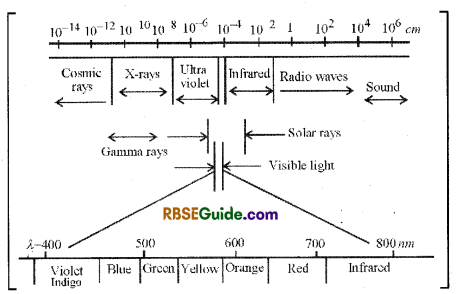
- This visible spectrum consists of seven colours (Violet; Indigo; Blue; Green; Yellow; Orange; Red) abbrevated as VIBGYOR and each colour has a definite wavelenght.
- The wavelength of red coloured light is 660 nm to 780 nm and that of violet coloured light is 390 nm to 430 nm.
- The region of wavelength higher than 760 nm is called infra red and the region of wave length shorter than 390 nm is called ultra violet.
- The electro magnetic rays contain energy in the form of energy packets. These high energy packets are called
photon.
- Energy contained in one photon is called quantum.
- In the process of photosynthesis, reduction of one molecule of CO2 requires 0-10 photon. This is called as quantum need of photosynthesis. The number of O2 molecules released per quantum is called quantum yield.
Note : Plants show maximum photosynthesis when blue and red region of light is supplied together. Rate of photosynthesis becomes zero when only green light is supplied.
Mechanism of Photosynthesis
1. Extensive work carried out on photosynthesis has brought the following facts to light.
2. Light energy absorbed by chlorophyll and the accessory pigments is used in photolysis of water. This reaction results in to release of O2, H+ and (e–).
3. The electrons so released flow through different electron acceptors.
4. During this electron transport energy of electron is stored in the form of ATP and NADPH + H+.
5. The high energy substances (ATP & NADP H + H+) are used in reduction of CO2.
6. This results in to production of carbohydrate.
7. Hence photosynthesis is oxidation-reduction process in which H2O is oxidised and CO2 is reduced.
Note : The complex process of photosynthesis is completed in two phases. The two- are clearly different but are interrelated phases.
I. Light Reaction :
- The first phase of photosynthesis requires presence of light and relates to photochemical reactions.
- These reactions take place in the grana region of chloroplasts.
- Assimilatory power is generated in this phase.
- The heat co-efficient of this phase is approximately one (Q10 = 1)
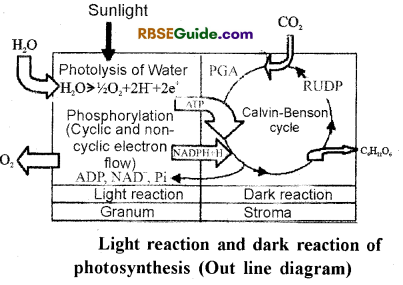
II Dark Reaction
- This phase of photosynthesis does not require presence of light and takes place after light reaction has taken place.
- These reactions take place in the stroma region of chloroplasts.
- Assimilatory power generated during light reaction is used in the reduction of CO2 in to carbohydrate.
- This phase is affected by temperature and heat coefficient of dark reaction is 2 or 3. (Q10 = 2 or 3).
![]()
(I) Light Reaction
- This phase is also called photochemical reaction or Hill’s reaction.
- This process involves several reactions leading to convertion of light energy in to chemical energy in the form of ATP and NADPH + H+ and evolution of O2.
This process in completed in following steps :
1. Absorption of light energy and excitement of chlorophyll molecule.
- Chlorophyll pigment absorbs quantum energy of electromagnetic rays of light and the chlorophyll molecule become excited.
- The energised electrons are emitted out of the excited chlorophyll molecules and are accepted by electron aceptor.

2. Photolysis of Water and Evolution of Oxygen.
- The energy absorbed by chlorophyll is used in break down of water into it’s component ions.
- Break down of H2O and formation of H+ and OH ions in the presence of light is called photolysis of water.
- This reaction results into liberation of Cf Some part of this is used in respiration and remaining CE is released in atmosphere.

3. Formation of NADPH + H+
- Hydrogen ions liberated in photolysis of water reduce NADP and form NADPH + H+.
- This process takes place on the surface of thylakoid membrane in contact with stroma.
- For oxidation of 2 molecules of NADP. 4H+ ions are required. These 4H+ ions are formed by photolysis of 2 molecules of water.
- This process also requires four electrons (4e ). which are obtained from PS-I.

- These 2 molecules of NADPH + H+ are used in reduction of one molecule of CO2.
4. Photophosphrylation :
- Energised electrons emitted out from the chlorophyll molecules excited by light energy, pass through a series of electron acceptors.
- Energy released during this electron transport is used in converting ADP in to ATP.
- This is called as photophosphorylation.

5. Red Drop, Emerson effect, Two Pigment system
Emerson et.al. (1957) studied effect of different wavelengths of visible spectrum on photosynthesis and observ ed the following:
(i) It was observed that there is a sharp decline in rate of photosynthesis when light of wave length greater than 680 nm is supplied to plant. As the decline in rate takes place when red region of visible spectrum is supplied it was called red drop.
(ii) In another experiment it was observed that when plants are supplied with light of shorter wave length along with longer wave length simultaneously (together), the rate of photosynthesis is more than the sum total of rate when both the shorter and longer wave length beams are supplied separately.
![]()
This enhancement in the rate of photosynthesis is called Emerson effect.
- On the basis of these observations, it was concluded that in plants at least two pigment systems are found.
- One pigment system absorbs light of longer wave length and the other one absorbs light of shorter wave length.
- These pigment systems are named as Pigment system I (PSI) and Pigment system II (PS II).
Note : The presence of two such systems has been supported by studies on chloroplast which showed two types of particles within the membrane, smaller and lighter particles of PSI and larger and heavier particles of PSII.
Pigment systems
The pigment systems I and II involved in the process of photosythesis are related with two photosystems called as photosystem I and photosystem-II respectively.
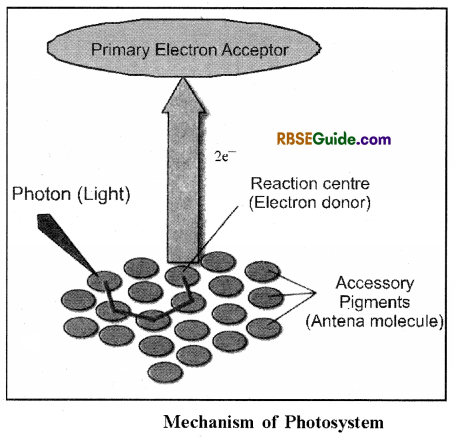
- Photosystem-I absorbs light of longer wave length.
- Photosystem-II absorbs light of shorter wave length.
- Each pigment system consists of 300-400 pigment molecules.
- In each pigment system there is present a reaction centre (Special chlorophyll ‘a’ molecule) around which accessory pigment molecules remain arranged.
- These accessory pigment molecules are called antena molecules.
- The antena molecules absorb energy and pass it to the reaction centre.
- Electrons are emitted out from reaction centre and accepted
Pigment System I or Photo system I (PS-I)
1. PSI consists of approximately 200 molecules of chlorophylls (Chl600. Chl670, Chl600, Chl690, Chl700) and about 50 molecules of carotenoids. These pigment molecules abosrob energy from light and transfer the energy finally to a special type of chlorophyll ‘a’ molecule called P700 which acts as reaction centre.
2. Photochemical reaction in the reaction centre results in to excitement of high energy electrons which are finally ejected out.
3. PS-I is situated in the thylakoid membrane in the grana as well as stroma region.
4. PS-I participates both in cyclic and non-cyclic photophosphorylation processes.
![]()
Mechanism of PS-I
- The reaction centre of PS-I is a special molecule of chlorphyll a called as P700.
- The photon particles bombard the pigment molecules of PS-I.
- The reaction centre absorbs this energy and electrons are ejected out of P700 molecule which gets oxidized.
- The electrons ejected out of PS-I pass from one electron acceptor to another and finally to NADP.
- As a result NADP is convereted in to it’s reduced form NADPH + H+
- NADPH + H +is a strong reductant and is used in dark reaction in reduction of CO2.
Pigment System II or Photo system-II (PS-II)
1. PS-II consists of 200 molecules of chlorophylls (Chl.650, Chl660 (Chl680), Chi b, about 50 molecules of carotenoids. These molecules absorb energy from light ancl transfer the energy finally to a special type of chlorophyll ‘a’ molecule called P680 which acts as reaction centre.
2. The antena molecules of PS-II absorb photon energy and transfer it to the reaction centre Pg80.
3. PS-H is located in the lamellae of grana region.
4. This photosystem participates in non-cyclic photophosphorylation only.
Mechanism of PS-II
- The reaction centre of PS-II is a special molecule of chlorophyll ‘a’ calledP680.
- The photon particles collide with pigment molecules of . PS-II.
- The reaction centre becomes excited and electrons are ejected out which are received by electron acceptor pheophytin.
- The oxidized pigment molecule acts as a strong oxidant and oxidizes water. This reaction is called photolysis of water.

- The electrons released in photolysis of water are received by P680 molecules which turns back to the ground state.
- The electrons received by pheophytin pass through plastoquinone, cytochrome-bfi, cytochrome-f and finally to plastocyanin.
- Electrons from plastocyanin are used in filling the electron hole (deficit) created by oxidation of reaction centre of PS-I.
- Hence plastocyanin acts as connecting link between PS- II and PS-I.
Electron Transport Chain-ETC
- During the process of photosynthesis energised electrons ejected out of chlorophyll travel from one electron acceptor to another.
- During this transport of electrons, energy equal to the difference between two acceptors is set free.
- ATP synthesis takes place in the step, where sufficient energy for converting ADP and iP into ATP is available.
- Energy released (set free) in other steps is lost as heat.
Photophosphorylation
The formation of ATP from ADP in chloroplast by use of light energy is called photophosphorylation.
This was discovered by Arnon et. al. (1954). Photo phosphorlyation is of two types :
1. Cyclic photophosphorylation and
2. Non-cyclic photophosphorylation
1. Cyclic photophosphorylation
- In cyclic photophosphorylation electrons ejected out from P700 return back to P700 and during their transport through various electron acceptors bring about ATP synthesis. Hence it is called cyclic photophosphorvlation.
- In this process only PS-I is involved.
- Electrons ejected out from reaction centre P700 travel through different electron acceptors such as
A(FeS) → Fd → Cyt. b6 → Cyt. f → Plastocyanin and are finally recycled to P700 - During this transport sufficent energy is released when electrons jump from Cyt. b6 to Cyt. f. and the energy is used in synthesis of ATP.
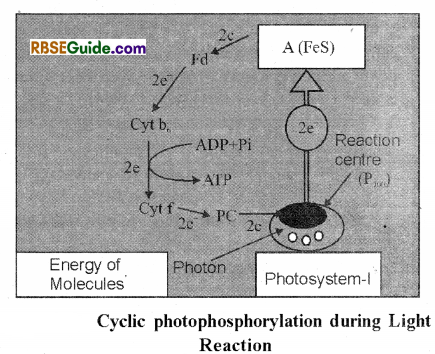
Non-Cyclic Photo phosphorylation
- In this process electrons ejected out from P680 do not return back to P680 and travel to different electron acceptors and during this flow bring about ATP synthesis. Hence it is called as non-cyclic photophosphorylation.
- In this process both PS-I and PS-II are involved.
- Electrons ejected out from reaction centre Pg80 flow through a series of electron acceptors such as Pheophytin
→ Plastoquinone (PQ)→ Cyt. bg → Cyt. f → Plastocyanin and finally lost to P700
- From P700 electrons flow to ferredoxin where they bring about reduction of NADP to NADPH + H+.
- During this flow sufficient energy is released when electrons jump from plastoquinone to cytochrom b6, and the energy is used in synthesis of ATP.
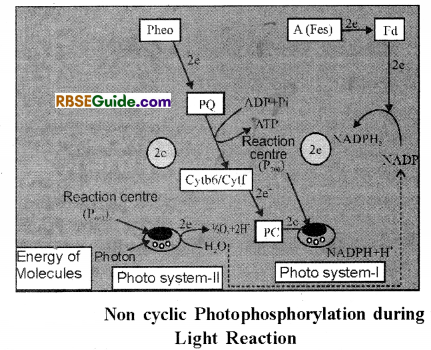
Note : The outcome of non cycle photophosphorylation is formation of ATP, generation of NADPH + H and release of oxygen (O2), Non cyclic photophosphorylation is also called Z scheme. A comparative account of cyclic and non cyclic photophosphorylation is given in the following table:
| Cyclic photo ph os phorylation | Non cyclic photophosphorylation | |
| 1. | Only PS-I participates | Both PS-I and PS-II participate |
| 2. | Photolysis of water does not take place | Photolysis of water takes place |
| 3. | O2 is not released | O2 is released |
| 4. | NADPH2 is not generated | NADPH2 is generated |
- The net result of the reactions of PS-I and PS-II is liberation of G2 by photolysis of water, synthesis of ATP molecules and generation of NADPH + H+
- The ATP and NADPH + H are used during dark reaction in reduction of CO2 and formation of carbohydrate.
Dark Reaction:
- Blackman (1905) discovered dark reaction of photosynthesis and all the biochemical reaction taking place during this phase were worked out by Calvin and Co¬worker.
- This phase of photosynthesis is completed in the stroma region of chloroplast and does not require presence of light.
- CO2 absorbed from atmosphere is reduced or is fixed in the form of carbohydrates.
- The energy used in fixation of CO2, is obtained from ATP and NADPH + H+ generated during light reaction.
- Dark reaction phase of the process of photosynthesis is also called carbon fixation process.
![]()
Note : Carbon fixation may take place by three different methods in green plants.
(A) Calvin-Benson Cycle – C3 Cycle
(B) Hatch – Slack Cycle – C4 Cycle
(C) Crassulacean Acid Metabolism – CAM
A. Calvin – Benson Cycle (C, Cycle)
- The path of carbon i.e. fixation of CO2 in carbohydrate was studied by Calvin-Benson and co-workers
(1946-1953) - These scientist used C14 carbon containing CO2, in the experiment carried out on unicellular alga Chlorella and Sceneclesmos.
- In this experiment, it was observ ed that during CO2 fixation the first stable compound formed is a three carbon (3-C) containing compound-Phosphoglyceric Acid. (PGA).
- Hence this process is called C, cycle.
- Calvin and Benson were awarded Noble Prize in 1961 for this work.
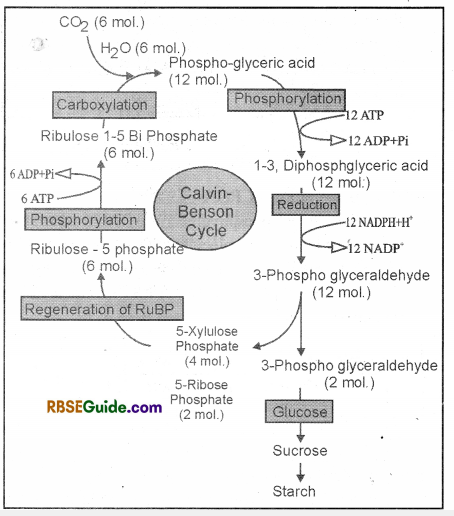
Note : The process of CO2 fixation in the form of carbohydrate is completed in the following steps :
(i) Phosphorylation of Ribulose monophosphate :
- During dark reaction, a five carbon compound-Ribulose bi phosphate acts as CO2, acceptor.
- This compound is formed by phosphorylation of Ribulose monophosphate in the presence of phospho pentokinase and ATP.
- For combining with 6 molecules of CO2, 6 molecules of Ribulose biphosphate are formed as per the equation given below

(ii) Carboxylation of 1-5-Biphosphate
- RuBP acts as acceptor of CO2
- 6 molecules of RuBP react with 6 molecules of CO2 and 6 molecules of water in the presence of carboxylase enzyme.
- This reaction results in the formation of 12 molecules of phosphoglyceric acid (PGA).
- Because PGA is a three carbon compound and is the first stable product of the process, hence dark reaction is also called C3 cycle.
- This reaction is also described as carboxylative phase of dark reaction.

(iii) Phosphorylation of PGA
- 12 molecules of 3 -phosphyglveeric acid formed as above, are converted in to 12 molecules of 1-3 diphosphoglyceric acid in the presence of enzyme phosphoglyceric kinase.
- In this reaction 12 molecules of ATP (formed in light reactions) are used and converted in to ADP.

(iv) Reduction of 1-3 diphosphoglyceric acid
- 12 molecules of 1-3 diphosphoglyceric acid are reduced to 12 molecules of 3 phosphoglyceraldehyde in the presence of enzyme triose phosphate dehydrogenase.
- The reduction of PGA into PGAL is brought about by the reducing power (NADPH + TF) generated during light reaction.
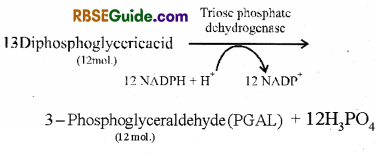
Note : Out of 12 molecules of 3-phosphoglyceraldehyde so formed, only 2 molecules react to form one molecule of hexose sugar. Remaining 10 molecules enter in a-series of complex biochemical reactions and regenerate 6 molecules of Ribulose monophosphate, which again enter into Calvin’s cycle.
![]()
(v) Formation of Hexose Sugar (Synthesis phase) : 2 molecules of 3 phosphoglyceraldehyde formed in reductive phase react to form one molecule of Glucose by following reactions:
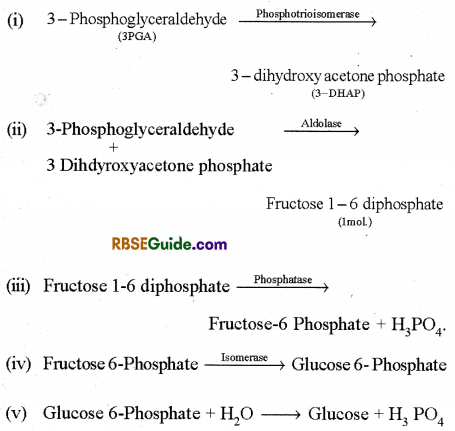
The above reactions are also called Glycolytic Reversion because these take place in opposite direction of Glycolysis.
(vi) Regnerative Phase or Regeneration of Ribulose 5- Monophosphate.
• We know that 6 molecules of CO2 and 6 molecules of Ribulose biphosphate react to form 12 molecules of phosphoglyceric acid in the beginning of Calvin-Benson cycle.
• We aslo know that 6 molecules of Ribulose biphosphate are formed by phosphorylation of 6 molecules of Ribulose- 5 monophosphate.
• Hence for continuity of the cycle, regeneration of 6 molecules of Ribulose 5-monophosphate is necessary at the end of cycle.
• This regeneration of 6 molecules of Ribulose 5 monophosphate takes place through the following reactions involving 10 molecules of PGAL formed during reductive phase.
(i) Formation of dihydroxy acetone phosphate :
4 molecules of 3-PGAL give rise to 4molecules of DHAP in the presence of triose phosphate isomerase.

(ii) Formation of Fructose 1-6 diphosphate : 2- molecules each of PGAL and DHAP react in the presence of Aldolase and form 2 molecules of Fructose

(iii) Formation of Fructose 6-Phosphate : Fructose 1-6 diphosphate reacts with H2O in the presence of enzyme phosphatase and. forms fructose 6-phosphate.

(iv) Formation of Xylulose and Erythrose sugars :
2 molecules of Fructose 6-phosphate react with 2 molecules of PGAL in the presence of enzyme ketolase and produce 2 molecules of Xylulose-5 phosphate along with 2 molecules of Erythrose-4 phosphate.

(v) Formation of Sedoheptulose 1-7 diphosphate : 2 molecules of erythrose-4 phosphate react with 2 molecules of DHAP in the presence of transaldolase to form 2 molecules of sedoheptulose 1-7 diphosphate. Sedoheptulose 1-7, diphosphate formed in this reaction combines with water in presence of phosphatase and converts in sedoheptulose

(vi) Formation of Ribose-5 phosphate and xylulose 5- phosphate :

(vii) An overview of the above reactions [(i)-(vi)] shows that 10 molecules of PGAL are involved in these and the outcome of the reactions is formation of 4 molecules of Xylulose 5-phosphate and 2 molecules of Ribose – 5- Phosphate . These molecules finally react to form 6 molecules of Ribulose monophosphate as shown below:
.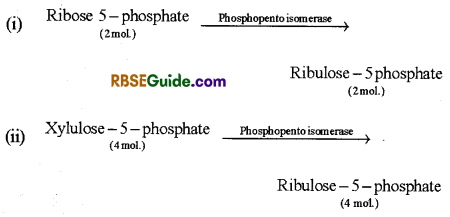
Thus the reactions of regenerative phase result in the formation of 6 molecules of Ribulose – 5- phosphate which change to 6 molecules of Ribulose 1-5 biphosphate (RuBP) by the following reaction

Hatch-Slack Cycle-(CH4 Cycle)
1. Kaprilav (1960) while working on maize and Kortschak et.al (1965) working on sugarcane plant observed that the first stable carbon compound of CO2 fixation in photosynthesis is a four carbon compound-oxaloacetic acid. (OAA)
2. M.D. Hatch and C.R. Slack (1966) confirmed the finding of Kaprilav and Kortschak et.al., and worked out complete path of carbon cycle in these plants. Hence this cycle is called Hatch-Slack cycle.
3. This cycle has been found to occur in monocot plants (Maize, Sugarcane, Pearl millet etc.) and also in some
dicot. plants (Amaranthus, Euphorbia etc.)
![]()
4. As the first stable carbon compound is not a C3 compound but a four carbon containing compounds-oxaloacetic acid, it is called as C4 Cycle or dicarboxylic acid cycle.
(a) Structural peculiarity of C4 plants
- The C4 plants have interesting type of leaf anatomy.
- In these plants two types of cells participate in photo-synthesis.
1. The mesophyll cells and
2. bundle sheath cells. - The mesophyll cells have small sized chloroplasts having chloroplasts well developed grana where as the bundle sheath cells have large sized chloroplasts without grana.
- Hence in C4 plants light reaction take place in the mesophyll
cells and dark reaction is completed in bundle sheath parenchyma. - The bundle sheath parenchyma are arranged around the vascular bundle of leaves in one or two layers or rings in the form of Wreath.
- In German language Wreath is called Kranz and hence leaf anatomy of this type has been called as Kranz anatomy.
(b) Mechanism of C4 Cycle
- Atmospheric CO2 enters the leaf through stomata and is absorbed by the mesophyll cells of C4 plants.
- Here a three carbon compound Phosphoenol pyruvate (PEP) acts as acceptor of CO2
- Phosphoenol pyruvate reacts with CO2, in the presence of carboxylase enzyme and forms a four carbon compound- Oxalo Acetic Acid (OAA).
- Oxaio acetic acid is reduced by NADPH + H + and is converted in to Malic acid.
- From mesophyll cells malic acid is passed to bundle sheath parenchyma
- In bundle sheath parenchyma, decarboylation of malic acid takes place and CO2, is released and pyruvic acid is formed.
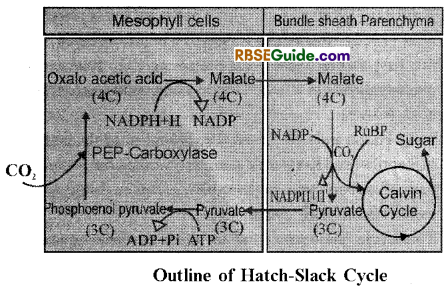
- Pyruvic acid passes back to mesophyll cells, where it is converted in to phospho enol pyruvate by the use of ATP molecules, and thus the cycle continues.
- CO, released in bundle sheath parenchyma, enters into C3 cycle and forms hexose molecule.
- Thus fixation of atmospheric CO2 takes place in the mesophyll cells through C4 cycle and conversion of CO2 into sugar takes place in bundle sheath parenchyma by C3 cycle.
(c) Importance of C4 plants and C4 cycle.
- C4 plants are capable of photosynthesis in relatively low concentration of CO2 and hence biologically important.
- Photorespiration does not occur in C4 plants and so the productivity of C4 plants is more than C3 plants.
- PEP carboxylase enzyme is active even at low concentration of CO2.
- C4 plants can successfully survive at place having shortage of water and high temperature (30°C – 45°C) and hence are more successful in tropics.
Main differences between C3 and C4 Cycle
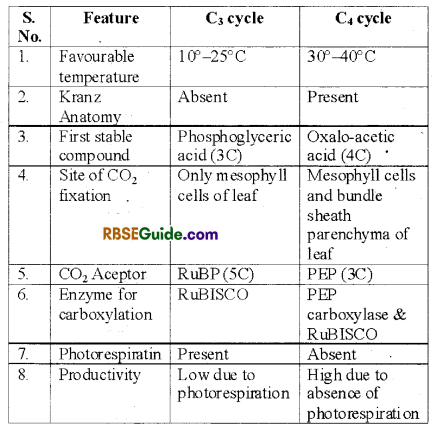
Crassulaceun Acid Metabolism (CAM)
1. Succulent plants growing in dry or xeric climate generally show crassulacean acid metabolism.
2. This metabolism was first studied in plants of family .Crassulaceae and hence it is named as CAM.
3. Some important examples showing this metabolism are Agave, Yucca, Crassula, Opuntia, Echinocactus etc.
4. The leaves in these plants are thick and fleshy and the stomata in these plants open during night and remain closed during day time.
5. Such stomata are called Scotoactive stomata
![]()
6. In these plants CO2 is absorbed during night when stomata are open, and reacts with phosphoenol pyruvate in presence of PEP carboxylase enzyme to form Oxalo acetic acid which converts in to malic acid.
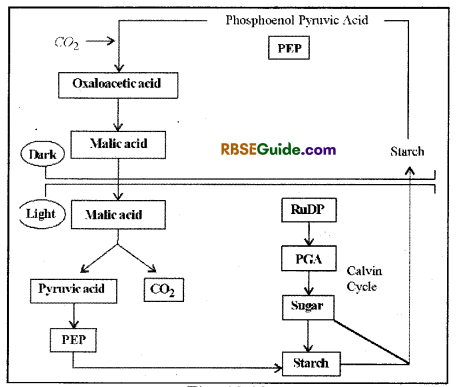
7. During day time CO2 is released by decarboxylation of malic acid and it enters Calvin cycle and is reduced to carbohydrate.
8. The most important aspect of CAM metabolism is that CO2 fixation takes palce during night and it’s reduction in to carbohydrate takes place during day time in the same cells.
9. This acts as physiological adaptation in succulent and Xerophytic plants.
10. This metabolism enables the plants to synthesize organic compound during day time by using solar energy without much loss of water.
Photorespiration
1. Definition: Respiration taking place, in addition to normal respiration, in photosynthetic parts of plant in the presence of sunlight is called photorespiration.
2. The term photorespiration was first used by Krotkov (1963). Prior to this Warberg (1920) observed that presence of high amount of 02 decreases rate of photosynthesis. This inhibition of the rate of photosynthesis by oxygen is called Warberg effect. Orgen and Bowes (1971) explained the mechanism of Warberg effect.
3. In this process organic compounds are oxidised by O2 and CO2 is released but energy is not released.
4. Oxidation of food material takes place by reactions similar to the process of respiration, but ATP formation does not take place and energy released is lost as heat. Hence, this is called as destructive activity.
5. The reactions of photorespiration are completed by involving three cell organelles – chloroplast, peroxisomes and mitochondria.
6. During day time when concentration of O2 becomes more than CO2, reactions of photorespiration become effective.
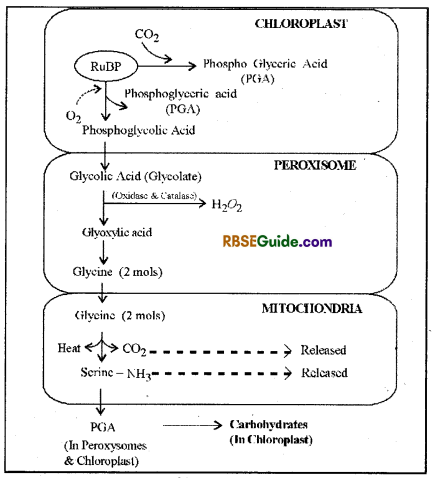
7. Orgen and Bowes observed that O2 and CO2 compete for enzyme RuBISCO.
8. This enzyme acts as Carboxylase in the excess of CO2 and as Oxygenase in the excess of O2
9. In excess of O2 RuBISCO acts as oxygenase and forms phosphoglycolic acid which is a two carbon compound. Hence it is called Glycolate cycle.
10. Glycolate cycle was first studied by Decker and Tio (1959).
11. Hence in excess of O2, formation of phosphglyceric acid is inhibited and rate of photosynthesis is reduced.
12. Phosphoglycolic acid converts into glycolic acid in the presence of enzyme phosphatase.
13. Glycolic acid comes out from chloroplast and enters peroxisome.
14. In peroxisome glycolic acid first changes in to glyoxalic acid and later oxidised into glycine.
15. From peroxisome glycine passes to mitochondria where two molecules of glycine react iwth 02 to form one molecule of serine and CO2 and NH3.
![]()
16. Energy released in these reactions is lost in the form of heat.
17. Photorespiration results into decrease in rate of photosynthesis in C3 plants upto 30-40%
Factors affecting Rate of Photosynthesis
The process of photosynthes is affected by atmospheric (external) and hereditary (internal) factors.
Atmospheric or external factors are light, CO2 availability, temperature, soil water, minerals etc. These factors may affect the process directly or indirectly.
Note : To understand this it is necessary to know about Sach’s cardinal point hypothesis and Blackman’s Law of Limiting Factor.
Sach’s Cardinal Point Hypothesis: According to Sach’s (18670) hypothesis, the amount of the factor which affects the rate of photosynthesis or any other physiological process has three values.
- Minimum amount,
- Optimum amount,
- Maximum amount.
Minimum amount : The amount of the factor at which the process of photosynthesis begins is called minimum amount. Below this the process stops or does not take place.
Optimum amount: “The amount of the factor at which rate of photosynthesis is highest and does not increase by increase in this amount, is called optimum amount.
Maximum amount: The amount of the factor at which the process takes place but beyond which the process stops is called maximum amount or maximum value. All the three conditions are called cardinal points.
Blackman’s Law of Limiting Factor :
1. Blackman (1905) proposed this hypothesis.
2. This hypothesis is a modification of Liebig’s law of minimum.
3. According to Blackman’s law of limiting factor, when rate of some process is influenced by several factors, then the rate of the process depends upon the factor which is present in the minimum amount.
4. This means that when all factors are present in a fixed amount, and the effect of one factor is observed, it is seen that as the amount of this one factor is increased, the rate of the process also increases. But at one stage increase in the amount of this factor does not increase the rate of the process because some other factor becomes limiting. This factor under study is called limiting fator.
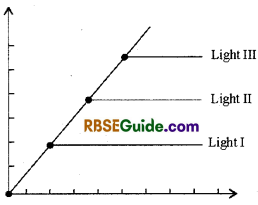
5. Example : Suppose all factors are available in sufficient amount but sunlight is available in minimum amount. At this stage, the rate of photosynthesis increases as light intensity increase. Here light is acting as limiting factor. After increasing light intensity, at some stage further increase in light intensity does not cause increase in the rate of photosynthesis because some other factor becomes limiting factor. Now if at this stage increase in C02 results in to increase in rate of photosynthesis, it is concluded that now C02 is acting as limiting factor. Hence, the factor which is available in relatively low amount, acts as limiting factor.
6. On an average only 3.0% of the total light is absorbed by chlorophyll pigment and remaining is reflected or refracted.
7. An increase in intensity of light may result in increase in photosynthesis if temperature and C02 are not limiting factor.
8. At a certain stage, further increase in light intensity fails to increase the rate of photosynthesis’because some other factor may become limiting factors.
9. Increase in light intensity beyond a certain limit may damage chloroplast and other cell organelles by photo-oxidation and phosynthetic apparatus is destroyed.
![]()
10. This is called Solarization.
Note: At a certain light intensity, the amount of C02 used in photosynthesis and amount of C02 produced in respiration become equal. This point is known as Compensation point.
(c) Duration of Light :
- It has been observed that plants may carry out photosynthesis when continuous light is supplied for relatively long period of time.
- Normally, 10 to 12 hours duration of light availability is required to help plants to carry out sufficient photosynthesis.
(ii) Temperature : Photosynthesis takes place in a wide range of temperature. Some gymnosperms such as Juniperus may perform photosynthesis at -35°C and in some xerophytes photosynthesis may take place at 5 5°C. Algae found in hot waters may perform photosynthesis at a high temperature of 75 °C. In maj ority of plants rate of photosynthesis gradually increases between 10°C – 3 5°C. At high temperature photosynthetic enzymes begin to get denatured. Binding of RuBISCO with CO2 decreases resulting in to decrease in rate of photosynthesis.
(iii) Carbon dioxide (CO2): The amount of carbon dioxide in atmosphere usually is 0.03% (300 ppm). As the amount of CO2 increases, rate of photosynthesis keeps on increasing up to some time untill some other factor becomes limiting factors. Normally rate of photosynthesis increases by increase in CO2 cncentration up to 1.0%, but increase in CO2 concentration beyond this has toxic effect on plants. Gaseous exchange stops due to closing of stomatal pore.
(iv) Water : Water is an important reactant in the process of photosynthesis. It acts as hydrogen donor in this process. Only 1.0% of total water absorbed by plants is used in photosynthesis. Hence normally water does not become limiting factor in photosynthesis. It may affect photosynthesis indirectly. Greater shortage of soil water may indirectly affect photosynthesis because shortage of water may cause closure of stomata. As a result gaseous exchange stops, water potential of leaf becomes low and enzymatic activity may be adversely affected.
(v) Oxygen : Increase in the concentration of 02 affects the rate of photosynthesis. Oxygen acts as competitive inhibitor for enzyme RuBISCO. In C3 plants RuBISCO begins to act as oxygenase enzyme in place of carboxylase under increased concentration of O2. At this stage photorespiration begins causing reduction in CO2 fixation.
Internal Factors
Rate of photosynthesis is affected by several internal factors i.e. plant related factors. Some of these are as follows:
1. Chlorophyll: Chlorophyll is the primary pigment related to photosynthesis and converts light energy into chemical energy. Normally rate of photosynthesis increases with increase in amount of chlorophyll if other factors remain optimum or do not become limiting factor.
2. Amount of stored food : The end product of photo synthesis is sotred in plant cells. The continous accumulation of the end products in the cells decreases rate of photosynthesis. The translocation of end products to other parts increases the rate again.
3. Internal structure of leaf: Rate of photosynthesis also depends on the number of stomata per unit area, their structure and distribution on leaves. Higher number of stomata and longer period of their opening promotes absorption of CO2 and hence rate of photosynthesis increases.
![]()
External Factors
(i) Light: Light is the most important factor because sunlight is source of energy for the synthesis of carboxydrates. Light may affect the process of photosynthesis in three forms.
(a) Type of Sunlinght : Only visible spectrum of sun light with wavelength 400 nm – 780 nm is used in photosynthesis. Rate of photosynthesis is highest when both blue and red part of light are supplied together to plant as compared to when these lights are supplied separately. Chlorolphyll absorbs more energy from these two parts of visible spectrum.
(b) Light intensity :
The amount of light absorbed by plants depends upon the form of the leaves and their arrangement (phyllotaxy).
